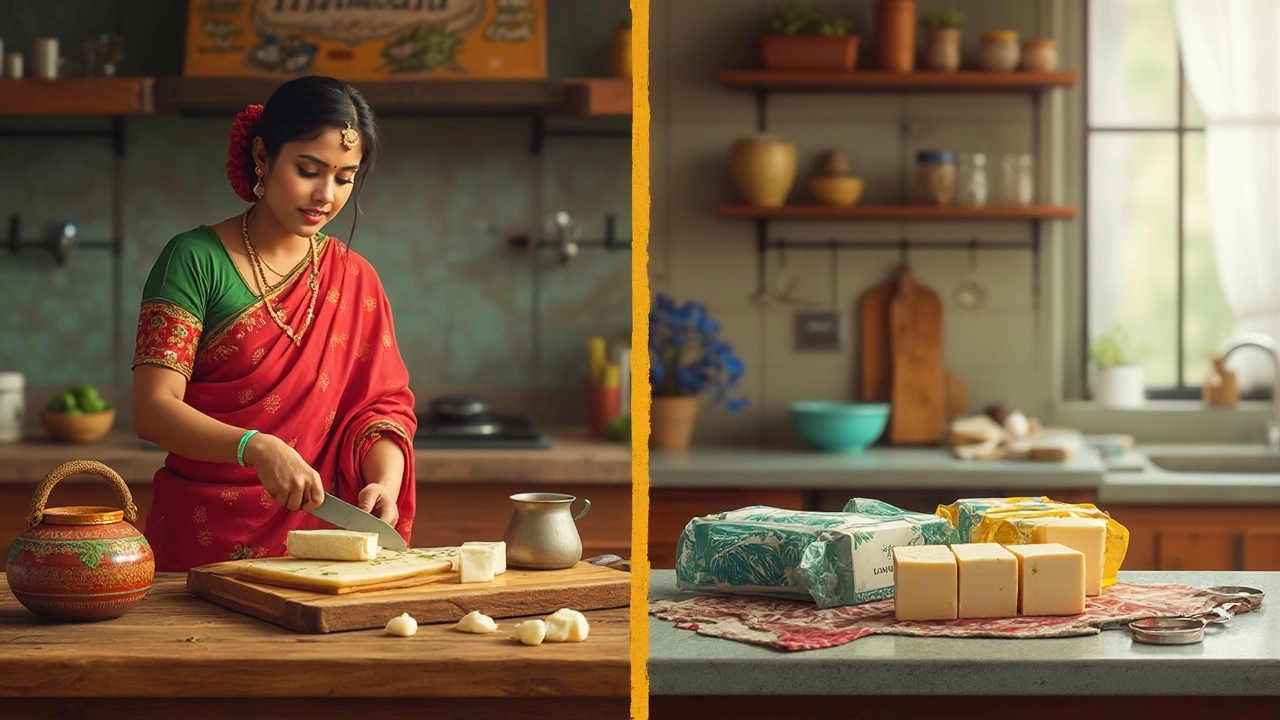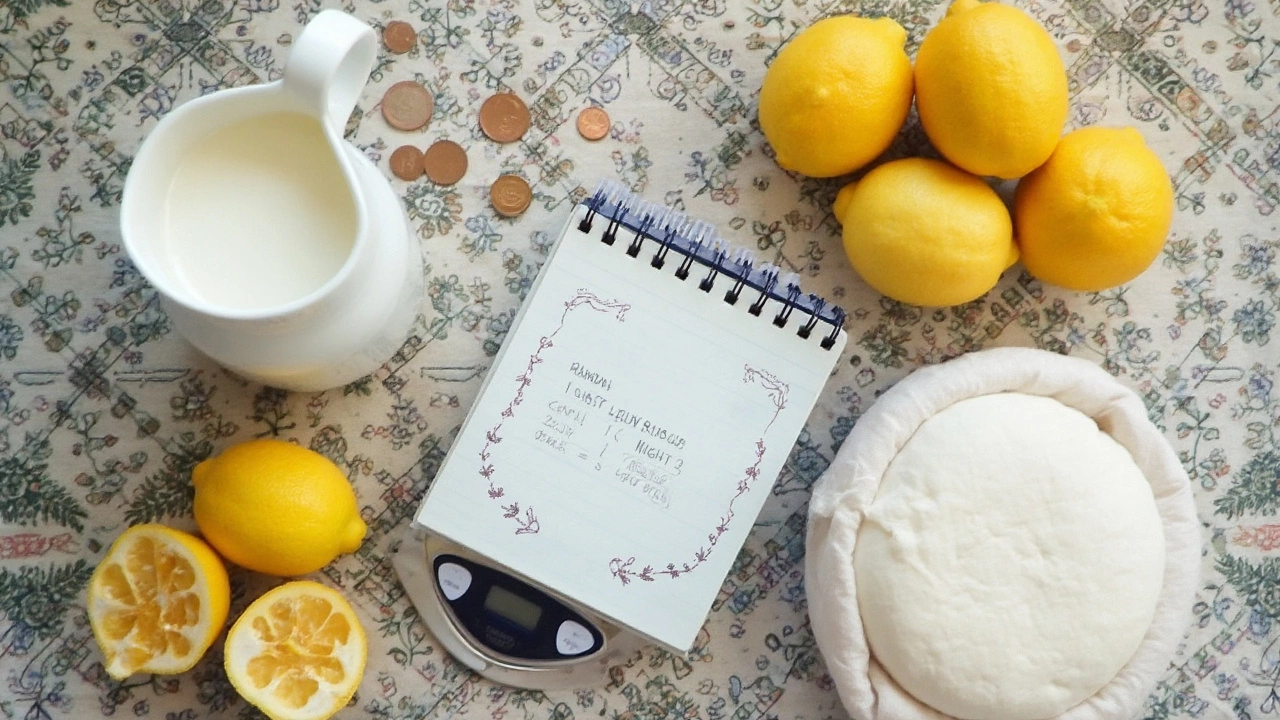Is It Cheaper to Make Paneer? Your Guide to Homemade Paneer Savings
 May, 16 2025
May, 16 2025
Ever stared at the price tag on those little blocks of paneer and wondered if you’re getting ripped off? You’re not alone. As prices keep creeping up, more people are eyeing homemade options and asking, “Is it cheaper to make paneer?”
Let’s get straight to it—making paneer at home isn’t some mysterious process. If you can boil milk, you’re already halfway there. But before you swipe that carton off the shelf, it’s smart to figure out just how much money you could save, or even if you’re saving at all.
First thing you should know: the only real ingredients you need are milk and some kind of acid, like lemon juice or vinegar. No hidden costs. The rest comes down to what kind of milk you buy, how much paneer you actually get from it, and if you’re okay with getting your hands a little messy for a better product.
- What Does It Actually Cost to Make Paneer?
- Comparing Store-Bought vs Homemade Paneer
- Quality and Taste: Does Homemade Paneer Win?
- Tips to Save Even More on Homemade Paneer
- Is Making Paneer at Home Worth Your Time?
What Does It Actually Cost to Make Paneer?
Let’s not waste time—let’s talk numbers. The cost of making paneer depends mostly on the price of milk. To get about 200 grams of paneer (which is the weight of a standard store-bought block), you’ll need 1 liter of full-fat milk. Right now, in most US or UK grocery stores, a liter of whole milk costs anywhere from $1 to $1.50 (about £1 to £1.20). Supermarket paneer, on the other hand, usually costs $3 to $5 (around £2.50 to £4) for the same 200-gram block.
It’s not just the milk, though. The only other thing you need is an acid like lemon juice or vinegar. You’ll use about 2 tablespoons, which costs almost nothing per batch—pennies, really. No fancy equipment is needed either: just a pot, strainer, and some cheesecloth or a clean towel from your kitchen.
| Ingredient | Amount Needed | Average Cost (USD) |
|---|---|---|
| Whole Milk | 1 liter | $1.25 |
| Lemon Juice/Vinegar | 2 tbsp | $0.10 |
| Total | ~200g paneer | $1.35 |
As you can see, the cost per batch is almost three times less than most pre-packed paneer. Sure, there’s a bit of energy used to heat the milk, but in most homes, that’s less than a couple of cents per batch—hardly worth worrying about.
One thing to remember: some types of milk—like skim or 2%—won’t give you as much paneer. Full-fat milk is best if you want a good yield and soft texture. It’s all about getting the best bang for your buck.
If you want the most savings and best results, use local full-fat milk, because it gives a richer paneer and more curds per batch. – "Modern Cookery for Teaching and the Trade," Thangam E. Philip
Bottom line: if you eat a lot of homemade paneer, making it yourself is way cheaper than buying it ready-made. Plus, you can use the leftover whey in soups or curries, getting even more value for your money.
Comparing Store-Bought vs Homemade Paneer
The question most people ask: are you really saving money by making homemade paneer instead of buying it from the store? Price is just one piece of the puzzle, but let’s break it down.
First up, here’s how the costs usually stack up, roughly based on 2025 prices for major cities in India and the US:
| Store-Bought Paneer | Homemade Paneer (from full-fat milk) | |
|---|---|---|
| Average price (per 200g block) | ₹70 / $3 | ₹45 / $1.80 |
| Main ingredients | Milk, preservatives, stabilizers | Milk, lemon juice or vinegar |
| Shelf life | 5-7 days (unopened) | 2-3 days (fresh) |
| Labor/time needed | None | About 30 minutes |
If you buy two liters of milk (costing around ₹50-60 in India or $2-2.50 in the US), you usually get about 200-250g of fresh paneer. That’s pretty close to what you buy in the store. But you skip preservatives and extra additives. Plus, it just tastes fresher.
There’s always the question of convenience. Grabbing a block at the market versus setting aside half an hour to make your own. But for many, it’s the clean ingredients that tip the scale. As Raghavan Iyer, respected Indian cooking expert, puts it:
“With homemade paneer, you control exactly what goes in. No weird chemicals, no funny aftertastes. Just simple, fresh cheese.”
Store-bought is handy, especially when you need paneer on a weeknight. But if freshness, taste, and ingredient control matter, homemade wins hands down. And when you factor in the cost, it honestly leans cheaper if you’re buying milk in bulk or snagging deals.
One little tip: save that leftover whey! It’s full of protein and perfect for doughs, curries, or even smoothies. That’s extra value you usually don’t get with the ready-made stuff.

Quality and Taste: Does Homemade Paneer Win?
If you’ve ever bitten into a block of store-bought paneer and felt underwhelmed, you’re not imagining things. Mass-produced paneer is mostly made for shelf life, not taste or texture. Most brands use ultra-pasteurized milk and heavy pressing, which gives that bland, chewy vibe. Not exactly what you’d want in your curry.
Homemade paneer, though, is a different story. You control the milk, the acid, and how much you press it. This means you get to choose whether you want softer, melt-in-your-mouth cubes for palak paneer or something firmer for grilling. Freshly made paneer has a creamy texture and a clean, milky flavor that just doesn’t come in a plastic packet.
Check out these real differences between store-bought and freshly made paneer:
| Store-Bought Paneer | Homemade Paneer | |
|---|---|---|
| Texture | Often rubbery or crumbly | Creamy, soft, slightly crumbly |
| Taste | Neutral or bland | Fresh, milky, richer |
| Preservatives | Usually added for shelf-life | None |
| Customization | None | Control salt, acidity, herbs |
Another underrated plus: when you make homemade paneer, you can tweak it. Want a touch of salt, or even a handful of chopped spinach or herbs mixed in? Totally doable at home, impossible from the store. And if you’re using full cream milk (even better if it’s from a local dairy), your paneer ends up way richer and less watery.
Some folks think homemade means complicated, but honestly, after a batch or two, you’ll probably find that you can tell the difference by taste blindfolded. If quality matters to you, the homemade route is the clear winner every single time.
Tips to Save Even More on Homemade Paneer
If you’re serious about cutting costs, these practical tricks will get you the most out of every homemade batch. Anyone can save money, but a few smart tweaks make a real difference.
- Buy milk in bulk or on sale: The price of milk is what decides how cheap your homemade paneer will be. Watch for discounts at your local store, or try warehouse clubs. UHT or long-life milk sometimes goes on crazy sales—grab it if you see it, since it lasts months.
- Go for full-cream milk: Skimmed or low-fat milk gives less paneer. To maximize your yield and get that real soft, chunky texture, use full-cream or whole milk. Avoid ultra-pasteurized (UHT) if you can, unless you’re stuck—as it usually forms less paneer.
- Reuse the leftover whey: Don’t pour that yellowish liquid down the drain! It’s loaded with protein and nutrients. Use it for kneading dough, making dals, or in smoothies. You can replace water in many recipes with whey, so you’re getting more out of the same batch.
- Adjust the acid: Lemon juice tends to be pricier than vinegar, but either works. White vinegar is the cheapest and produces a firmer paneer. If you don’t mind a hint of vinegar taste, use that for the best savings.
- Don’t skimp on draining and pressing: Line your colander with a clean, thin cotton cloth or even a (new, washed!) dish towel. Squeeze out excess water thoroughly. The firmer you press, the more paneer per cup of milk.
Some quick numbers help put things into perspective. Here’s a quick table showing roughly how much homemade paneer you’ll get per liter (or per gallon) of milk, plus the average pricing difference (all based on 2025 prices):
| Milk Type | Avg. Paneer Yield (grams) | Avg. Cost per 250g Block (Homemade) | Avg. Store Price per 250g |
|---|---|---|---|
| Full-Cream, Store Brand | 180-200 | ₹45-55 (India), $2-2.50 (US) | ₹70-90 (India), $3.99-$5 (US) |
| Low-Fat | 90-120 | ₹55-65 (India), $2.20-2.70 (US) | ₹70-90 (India), $3.99-$5 (US) |
Here’s a pro tip: if you make paneer regularly, consider teaming up with friends or neighbors and buy milk in bigger packs to split the savings. Plus, homemade paneer freezes well if you press out all the liquid first. Wrap it tight, and you’ve always got a backup block ready to go.

Is Making Paneer at Home Worth Your Time?
So you’re sold on the idea of homemade—but let’s be real, time is money too. Making homemade paneer doesn’t mean you’re chaining yourself to the kitchen all afternoon. It’s mostly hands-off; you just heat milk, add acid, and wait for curds to form. Actual hands-on work? Maybe 10-15 minutes for a small batch.
If you break it down, here’s what the time commitment looks like for a batch that gives you about 200 grams of paneer:
| Step | Time Spent |
|---|---|
| Heating milk | 10 mins |
| Adding acid, letting curdle | 2-3 mins |
| Straining & pressing | 10-15 mins (includes draining time) |
Total: Around 20-25 minutes, most of that is passive. Don’t expect to stand over the stove the whole time. Plenty of folks multitask or just use this as a quick kitchen break.
But what about comparing this with store-bought? At the store, grab-and-go is easy, but you’re also paying for packaging, freight, and profits for the store. The main perk with homemade? No weird additives, fresher taste, and the flexibility to make it just the way you like—firm or soft, as salty or mild as you want.
If you cook with paneer often—like once or twice every week—those savings start to add up. Families can easily save ₹30-50 a week by making their own instead of buying a 200g pack. Over a year, that’s enough for a fun dinner out or a couple of movie tickets, just from switching to DIY.
And if time is super tight, double up your batch and freeze extra cubes. Paneer freezes well for up to two months, especially if you leave it in larger chunks and wrap them tight.
Bottom line? If you care about freshness, purity, and saving some cash (especially as prices go up), making paneer yourself wins. Once you get in the groove, it just becomes another easy kitchen habit—no stress, no sweat.